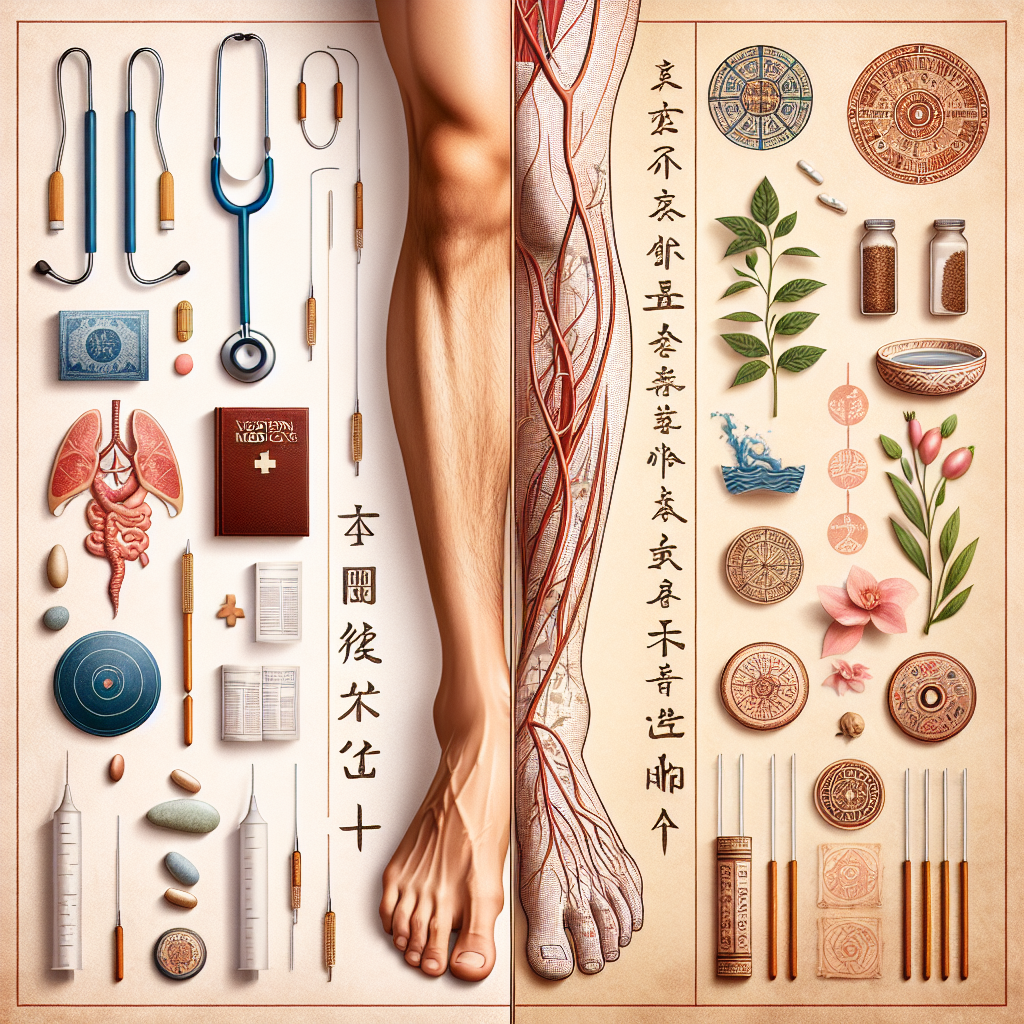Varicose Veins: Bridging Western Medicine and Eastern Traditions for Comprehensive Treatment
Varicose veins are a common vascular condition that affects millions of people globally, manifesting as swollen, twisted veins often visible just under the surface of the skin. While varicose veins most commonly appear in the legs, they can form in other parts of the body as well. They occur due to the malfunctioning of vein valves, leading to improper blood flow and pooling. Symptoms can range from mild discomfort to significant pain and complications like ulcers or blood clots. The treatment of varicose veins has been approached differently by Western medical practitioners and Eastern traditional healers, each offering unique perspectives and methodologies that can potentially complement one another for comprehensive care.
Western Medical Approaches
Western medicine typically approaches varicose veins with a focus on both symptomatic relief and correction of underlying venous insufficiency. The treatment strategies can be broadly classified into conservative management, minimally invasive procedures, and surgical interventions.
Conservative Management:
Western medicine often recommends lifestyle changes as an initial approach to managing varicose veins. This includes weight management, regular exercise, leg elevation, and avoiding prolonged periods of standing or sitting. Compression stockings are also frequently prescribed to help improve blood flow and reduce symptoms. These stockings apply gradient pressure to the legs, which helps veins and muscles move blood more efficiently.
Minimally Invasive Procedures:
When conservative management is insufficient, Western medicine offers various minimally invasive procedures. Sclerotherapy is one of the oldest and most commonly used techniques, involving the injection of a sclerosing agent into the affected vein, causing it to collapse and eventually be absorbed by the body. Another popular method is endovenous laser therapy (EVLT) or radiofrequency ablation (RFA), where heat generated by laser or radiofrequency energy is used to close off the problematic vein.
Surgical Interventions:
For severe cases, surgical options such as vein stripping and ligation may be necessary. These procedures involve the removal or tying off of the problematic veins. Although effective, these surgeries require longer recovery times and carry the risks inherent to invasive procedures, such as infection and scarring.
Eastern Traditional Approaches
Eastern medicine, particularly Traditional Chinese Medicine (TCM) and Ayurveda, addresses varicose veins with a holistic approach that aims to balance the body’s energy and improve overall health.
Traditional Chinese Medicine (TCM):
In TCM, varicose veins are viewed as a manifestation of underlying imbalances in the body, particularly related to Qi (life energy) and blood flow. TCM treatments aim to improve circulation, strengthen vein walls, and address the root cause of the imbalance.
Herbal Medicine:
TCM practitioners often prescribe a combination of herbs to improve blood circulation and reduce inflammation. Common herbs include Dang Gui (Angelica sinensis), which is believed to nourish the blood and promote circulation, and Dan Shen (Salvia miltiorrhiza), which has been shown to have vasodilatory and anti-inflammatory properties.
Acupuncture:
Acupuncture involves the insertion of fine needles into specific points on the body to stimulate energy flow and restore balance. For varicose veins, acupuncture points may be used to enhance blood circulation and reduce pain and swelling. Studies have indicated that acupuncture can improve microcirculation and reduce venous pressure, providing symptomatic relief.
Moxibustion:
Moxibustion, a therapy involving the burning of the herb mugwort near the skin, is often applied to warm and invigorate the flow of Qi and blood in the body. This technique is believed to help in reducing the stagnation that contributes to varicose veins.
Ayurveda:
Ayurvedic medicine, an ancient Indian system of medicine, focuses on the balance of the body’s three doshas: Vata, Pitta, and Kapha. Varicose veins are often considered a Vata disorder, characterized by poor circulation and stagnation.
Herbal Remedies:
Ayurvedic treatments often involve the use of herbs such as Gotu Kola (Centella asiatica), which is renowned for its beneficial effects on blood circulation and vein health. Other herbs like Guggul (Commiphora mukul) and Ashwagandha (Withania somnifera) are also used for their anti-inflammatory and rejuvenating properties.
Panchakarma:
Panchakarma, a series of detoxification and rejuvenation therapies, aims to cleanse the body of toxins and improve overall health. Treatments may include therapeutic massages, steam baths, and herbal enemas, which help in improving circulation and reducing venous congestion.
Bridging Western and Eastern Approaches
While Western and Eastern approaches to treating varicose veins differ significantly, integrating the strengths of both can offer a more comprehensive and holistic treatment strategy.
Complementary Techniques:
Combining Western medical procedures with Eastern therapies can help manage both the symptoms and underlying causes of varicose veins. For instance, a patient undergoing sclerotherapy might also benefit from acupuncture to enhance overall circulation and reduce post-procedural discomfort. Similarly, integrating herbal remedies from TCM or Ayurveda with lifestyle modifications advised by Western practitioners can offer a more rounded approach to managing the condition.
Patient-Centered Care:
Both Western and Eastern approaches emphasize the importance of tailored treatments based on individual patient needs. A comprehensive treatment plan for varicose veins might include minimally invasive procedures to address the immediate vascular issues, complemented by Eastern practices like acupuncture and herbal medicine to promote long-term vascular health and overall well-being.
Research and Collaboration:
Ongoing research and greater collaboration between Western and Eastern practitioners can pave the way for evidence-based integrative treatments. Clinical studies examining the efficacy of combined therapies can help in refining treatment protocols and improving patient outcomes.
Conclusion
Varicose veins, though often dismissed as merely a cosmetic issue, can significantly impact quality of life. Western medicine offers effective solutions through both conservative and invasive techniques, while Eastern traditions provide holistic approaches that address underlying imbalances. By bridging these two worlds, patients can benefit from a comprehensive treatment plan that not only alleviates symptoms but also promotes overall health and well-being. Integrative care that embraces the strengths of both Western and Eastern medicine holds the promise of more effective and personalized treatment for individuals suffering from varicose veins.

